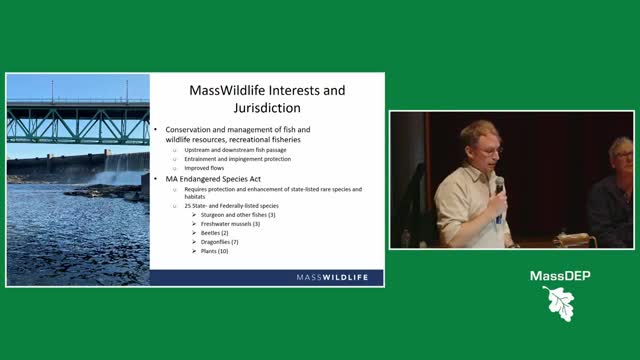Connecticut River faces ecological crisis as 75% of its length is dammed
October 10, 2024 | Massachusetts Department of Environmental Protection, Executive , Massachusetts
This article was created by AI summarizing key points discussed. AI makes mistakes, so for full details and context, please refer to the video of the full meeting. Please report any errors so we can fix them. Report an error »

The recent MassDEP FirstLight 401 Water Quality Certification Public Information Session held on October 10, 2024, highlighted critical discussions surrounding the ecological impacts of dams, particularly focusing on the Connecticut River. The meeting served as a platform for stakeholders to address the significant environmental challenges posed by dam infrastructure in the region.
One of the key topics discussed was the detrimental effect of dams on river ecosystems. Experts emphasized that healthy rivers are vital for supporting diverse native species and maintaining biodiversity. Unlike smaller rivers, large rivers with minimal impoundments provide essential habitats and natural seasonal flow patterns that native species are adapted to. In contrast, dams create artificial impoundments that disrupt these natural processes, leading to reduced biodiversity and hindering the migration of fish and wildlife.
The Connecticut River, noted as one of the most dammed rivers in the United States, exemplifies these challenges. With 14 dams along its main stem and over 1,000 on its tributaries, approximately 75% of the river's 400-mile length is currently impounded. This extensive damming transforms the river's ecosystem, causing it to function more like a series of lakes rather than a flowing river. Only about 25% of the river remains free-flowing, and even these sections have suffered from decades of flow alterations.
The discussions at the meeting underscored the urgent need for action to address these ecological impacts. Stakeholders recognized the importance of restoring natural river conditions to support the recovery of native species and enhance biodiversity. As the meeting concluded, participants expressed a commitment to exploring solutions that could mitigate the adverse effects of damming on the Connecticut River and its surrounding ecosystems.
The implications of these discussions are significant, as they not only affect local wildlife but also the broader environmental health of the region. Moving forward, the MassDEP and involved parties will need to prioritize strategies that balance human needs with ecological preservation to ensure the sustainability of the Connecticut River and its diverse habitats.
One of the key topics discussed was the detrimental effect of dams on river ecosystems. Experts emphasized that healthy rivers are vital for supporting diverse native species and maintaining biodiversity. Unlike smaller rivers, large rivers with minimal impoundments provide essential habitats and natural seasonal flow patterns that native species are adapted to. In contrast, dams create artificial impoundments that disrupt these natural processes, leading to reduced biodiversity and hindering the migration of fish and wildlife.
The Connecticut River, noted as one of the most dammed rivers in the United States, exemplifies these challenges. With 14 dams along its main stem and over 1,000 on its tributaries, approximately 75% of the river's 400-mile length is currently impounded. This extensive damming transforms the river's ecosystem, causing it to function more like a series of lakes rather than a flowing river. Only about 25% of the river remains free-flowing, and even these sections have suffered from decades of flow alterations.
The discussions at the meeting underscored the urgent need for action to address these ecological impacts. Stakeholders recognized the importance of restoring natural river conditions to support the recovery of native species and enhance biodiversity. As the meeting concluded, participants expressed a commitment to exploring solutions that could mitigate the adverse effects of damming on the Connecticut River and its surrounding ecosystems.
The implications of these discussions are significant, as they not only affect local wildlife but also the broader environmental health of the region. Moving forward, the MassDEP and involved parties will need to prioritize strategies that balance human needs with ecological preservation to ensure the sustainability of the Connecticut River and its diverse habitats.
View full meeting
This article is based on a recent meeting—watch the full video and explore the complete transcript for deeper insights into the discussion.
View full meeting
